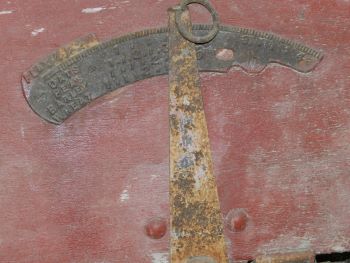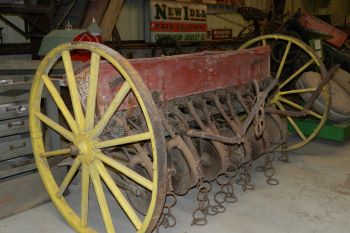Grain Drill
Seeding Grain
In the olden days, seeding grain was done literally by hand. The farmer walked the field with a container of seed grain scattering handfuls as he walked. The coverage was of course uneven, and the field would have to be dragged afterwards to cover the seed with a thin layer of soil. Meanwhile, the birds were having a “field day” pecking up the scattered seed grains. Early mechanization came in the form of an “end gate seeder” – a wagon with a horizontal rotating disk at the back driven by a rear wheel to scatter the seed grain. The principle is the same as the disk on the back of a modern snowplow truck used to scatter sand on ice. It made the job easier, but the problem of even seed dispersion and covering the seed remained.
The grain drill pulled by horses evolved to “drill” the seed grain into the ground, dispensing the seeds more or less evenly and covering them. The Museum has an example of a wood and metal Van Brunt six-foot grain drill on display. The basic design of this type of drill did not change significantly for perhaps three-quarters of a century until the advent of large-scale farm machinery.
The drill consists of two large wheels connected by an axle. Mounted above the axle was a covered seed grain box that tapered down to the width of a series of rectangular slots in the bottom where the seed fed out. A second square shaft was connected by gears with a gear on each wheel hub, with a lever to engage and disengage it. There were actually two square shafts, geared to the left and right wheels of the drill. Note that the shafts were directly geared, so they always turned at the same slower speed relative to the wheel on that side. In a turn, the outside wheel would rotate faster and more seed would be planted on that side. An ingenious mechanism on the square shaft allowed varying the seeding rate even though the shaft speed remained the same. Mounted on the rotating shaft under each slot of the grain box was a round or fluted “feed cutoff” cylinder next to a rotating splined “feed roll” (like a toothed gear). The cutoff plugs part of the feed slot, while the splined feed roll carries seeds out. To vary the seeding rate and type of seed, the square shaft could slide back and forth a couple inches, exposing more or less of the splined feed roll. Two levers mounted on the back of the drill box controlled the rate, according to a scale giving seeding rate for different types of seed. Very little spline was used for small seed like flax and much more spline for large seed like oats. And woe betide the farmer who forgot to change the lever settings when switching the type of seed. Below the axle are coulters (disks) spaced about six inches apart. Each coulter is angled slightly relative to the drill, and opens a shallow narrow furrow. Dispensed seed falls down through a tube behind each coulter After they pass, the soil slumps back together again to cover the seeds. Short drag chains trail on the ground behind each coulter to help in covering the seeds. The coulters were adjusted up and down with leavers to set the depth at which the seeds were planted. On one side was another gear on the axle connecting to a “land measurer” that measured the wheel revolutions and recorded the distance traveled in acres while seeding. About 10 acres per day could be seeded with a two-horse team.


SOURCES:
Miller, Lynn R. Work Horse Handbook. Small Farmer’s Journal, Inc. 1981.
Telleen, Maurice. The Draft Horse Primer. Rodale Press. 1977.
John Deere Company. The Operation, Care, and Repair of Farm Machinery, 19th edition.
.
By Don McCollor. October 2022
Photo by Linda Westrom

